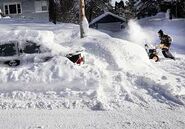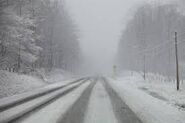The North Texas Snowstorm of 2022 was a historic snow event that buried the Southern United States , most notably North Texas, with over 2 feet of snow from January 16 to January 19. It had origins from a shortwave trough extending from British Columbia down to Baja California during January 14-15. A state of emergency was declared for 5 southern states on January 15, with blizzard warnings issued in 2 states. Over 15 million were affected by the snowstorm, including over 2 million who lost power. The storm also claimed 16 fatalities . On the RSI, the storm ranked as ''Category 4 Crippling''.
Meteorlogical History[]
On January 14, a shortwave trough formed over British Columbia, Canada. During the next two days, it moved southward through the Pacific Coast region. The National Weather Service began monitoring it on the day it formed for possible storm development. On January 15, it became clear that it would soon develop into a storm. Forecasters in the Southeastern U.S. began predicting up to 8 inches of snow in certain areas. On January 16, the trough spawned a surface low over Baja California, a defined-low pressure area. At the time, the minimum barometric pressure was 1,004 millibars. The system then began to track towards the east while frontogenesis took place. As a result of that and other moisture coming in from the Pacific Ocean, rain began falling in Southern California and Arizona, becoming snow in mountainous areas. During the afternoon hours of January 16, the low began to weaken over the mountainous terrain of Central Mexico. However another weakening low pressure system in the Gulf of Mexico began feeding the original low. At that time, forecasters began upgrading their snowfall totals. By the afternoon of January 17, the system had absorbed all of the secondary lows energy while it was located over South Texas and bombogenesis took place . Subsequently, the system moved into the Gulf of Mexico and bombed out to 976 millibars while it was located 100 miles offshore of Houston, Texas. Afterward it began to weaken during January 18-19. By the morning of January 19, the minimum barometric pressure increased to 1,000 millibars as it moved ashore of Florida. After crossing Florida, the system then tracked off the coast of Georgia and the Carolinas, while precipitation totals decreased. It reached the Mid-Atlantic region on January 20 before turning toward the northeast. By January 21, the system had completely left the East Coast of the United States.
Preparations[]
The National Weather Service issued watches and warnings from their offices in 4 states on January 15. Winter Storm warnings were issued for Northeastern Texas, Northern Louisiana, Northern Alabama and Northern Georgia. On January 16, the warnings in Northeastern Texas and Northern Louisiana were upgraded to Blizzard warnings. Storm warnings were issued in the Northern Gulf of Mexico. On January 15-17, the governors of Texas, Louisiana, Alabama, and Georgia declared a state of emergency due to high forecasted snowfall totals. Over 2,500 flights were canceled between January 15-19, mainly at Dallas/Fort Worth and Hartsfield Jackson Atlanta International Airports. As a result ripple effects were felt internationally. Amtrak suspended service on the Texas Eagle, City of New Orleans, and the Crescent. Some concerts and sporting events were also postponed by the storm. Also because of the storm, an 850 mile section of Interstate 20 was closed.
Texas[]
A snow emergency was declared for several northeastern counties on January 16 including Dallas and Fort Worth. People were forbidden from parking on snow emergency routes after 4:00 CST. Schools in the Dallas-Forth Worth area were cancelled for January 17 due to impending blizzard conditions. The Texas Department of Transportation deployed over 7,500 snowplows and salt trucks to keep roads clear. The state's national guard was mobilized for January 15. On January 16, DART and TRE service was shutdown for January 17 and 18. All flights all Dallas/Fort Worth International Airport and Love Field were cancelled on January 16 for January 17 and 18. In South Texas, advisories were also issued for heavy rain and coastal flooding including urban areas like Corpus Christi and Houston. Strong winds and storm surges also posed a threat to coastal areas. Waves were expected to reach 7 to 8 feet.
Louisiana[]
A state of emergency was declared for Northern Louisiana on January 15. Schools in the Shreveport and Monroe areas were closed for January 17-18. Over 4,500 salt trucks and snowplows were deployed to clear roads. The state national guard was placed on standby on January 16. On January 17, a travel ban was issued for Shreveport due to numerous snow related incidents. Further south, Storm surge and Coastal flood warnings were issued. Storm surges were expected to reached 8 to 9 feet. In southern areas of the state, heavy rainfall was also anticipated.
Mississippi[]
A state of emergency was declared for Mississippi on January 15. Schools in Meridian and Jackson were closed for January 17-18. The state's national guard stood by beginning on January 16. Salt trucks and snowplows in numbers of 3,000 were put on duty to clear roads. Coastal areas received Storm surge and Coastal flood warnings. Southern areas of the state were also expected to receive heavy rain.
Alabama[]
A state of emergency was declared for Northern Alabama on January 15. Heavy snowfall projections caused flights to be cancelled at Birmingham and Huntsville airports for January 18. Schools in the major metro areas were closed for January 18. Salt trucks and snowplows in quantities of 4,000 were deployed to keep roads clear of snow and ice. Near Mobile, Coastal flood and storm surge warnings were issued. Southern areas of the state were projected to receive heavy rain.
Georgia[]
A state of emergency was declared for Northwestern Georgia on January 15. A snow emergency was declared for Atlanta on January 17. Salt trucks and snowplows were deployed as well as the state's national guard on the same day. Cars were forbidden from parking on snow emergency routes after 2:30 PM EST. Schools in Atlanta were closed for January 18. All flights at Hartsfield Jackson Atlanta International Airport were cancelled for January 18, 19, and 20. Further south, heavy rainfall was projected.
Florida[]
Although snow was not forecast to fall in Florida, heavy rainfall, coastal flooding, and storm surges were expected to pose a threat to residents in the northern areas of the state.
Impact[]
[]
More than 15 million were affected by the snowstorm. It claimed 16 fatalities, 3 in Texas, 6 in Louisiana, 2 in Alabama, 3 in Georgia, 1 in Mississippi, and 1 in Florida. More than 2 million people lost power, 640,000 in Texas, 410,000 in Louisiana, 50,000 in Mississippi, 50,000 in Alabama, 800,000 in Georgia, and 50,000 in Florida. In the South and Southeast, the RSI number was 17.183 ranking it as ''Category 4 Crippling'' in those two regions. Travel was also disrupted. In Dallas/Forth Worth and Atlanta, it became the biggest snowstorm on record.
Southwest[]
Heavy rain fell across Southern California, Arizona, and New Mexico, turning to snow at higher elevations. All of the major mountain passes in Southern California were closed due to heavy snow. San Gorgonio Pass recorded 6.3 inches of snow, a new daily record for January 16. Trace amounts fell as low as 1,000 feet, causing traffic on the low mountain to slow to a near-standstill. In El Centro, two people were injured after their car skidded on wet pavement from heavy rain, and crashed into a brick wall. In Arizona, heavy rain and snow caused mudslides in the Phoenix area. As a result, 24 cars became stranded. Up to 18 inches of snow fell at higher elevations. I-17 was closed between Camp Verde and Flagstaff due to snow drifts blocking the highway. In New Mexico, heavy rain and snow caused many mountain roads to be closed. Heavy snow fell across the Eastern Plains on the afternoon of January 16, peaking at 22.3 inches in Ruidoso. One person in Roswell was injured after hitting himself in the head with a snow shovel.
Texas[]
Heavy snowfall occurred across North Texas. Dallas-Forth Worth International Airport set a new all-time record of 21.2 inches of snow. Here are other snowfall totals from other parts of the metro area
Downtown Dallas: 20 inches
Downtown Fort Worth: 19.5 inches
Arlington: 20.4 inches
Irving: 20.2 inches
Grapevine: 23 inches
Garland: 24.4 inches
Plano: 26 inches
Frisco: 28.2 inches
Denton: 28 inches
McKinney: 31.4 inches


